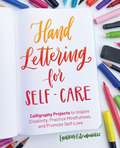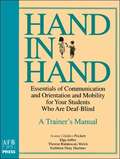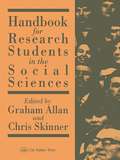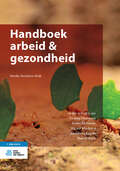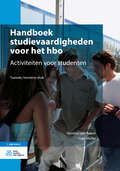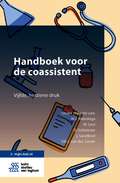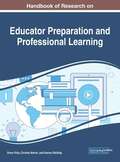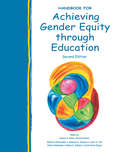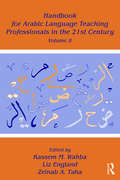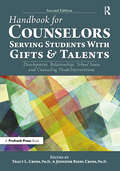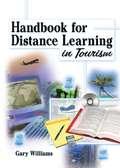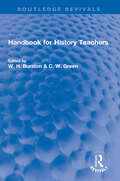- Table View
- List View
Hand Lettering for Beginners: Simple Techniques. Endless Possibilities.
by Sarah EnsignCreate beautiful lettering projects, quotes, birthday cards, and more once you&’ve learned the basics of hand lettering from artist Sarah Ensign. Have you always wanted to learn the secrets to create stunning letter art? Now you can! This book takes you through different hand lettering styles such as faux calligraphy, brush pen lettering, and creating basic font styles such as monoline, elegant, and brush pen scripts. Sarah Ensign, author and influencer shares this fascinating craft with you through pages of colorful examples and worksheets that allow you to practice what you&’ve learned. She also shares practical tips on supplies such as pen and paper, creating beautiful fonts, and master tricky connections, and planning layouts for quotes. Simple Techniques and Endless Possibilities In this colorful, hardcover book, you&’ll find hands-on lettering worksheets and step-by-step guides that will quickly build your confidence. Explore your creativity with this fun, creative craft. Hand lettering for Beginners has a fun, non-intimidating approach to guiding readers through hand lettering techniques and possibilities. This book will start a fascinating hobby that will allow you to grow your hand lettering skills and create your own unique projects.
Hand Lettering for Self-Care: Calligraphy Projects to Inspire Creativity, Practice Mindfulness, and Promote Self-Love
by Lauren Fitzmauricehand lettering; lettering for beginners; letter tracing; letter shaping practice; DIY art projects; arts and crafts activity book; calligraphy training; lettering and modern calligraphy; lettering workbook; lettering books for beginners; hand lettering book for beginners; hand lettering 101; coloring for self care; crafts for anxiety; coloring for anxiety; books for self-care;
Hand in Hand: A Trainer's Manual
by Elga Joffee Jeanne Glidden Prickett Kathleen Mary Huebner Therese Rafalowski WelchAn in-service training guide that presents structured information and guidelines for using the Hand In Hand materials with various audiences. Focusing on the needs of the trainer, this manual provides sample blueprints for individual workshops, as well as an overview of training, assessment, and evaluation. Also includes sample forms for conducting a pre-training needs assessment and post training evaluation.
Hand in Hand: Essentials of Communication and Orientation and Mobility for Your Students Who Are Deaf-Blind: Volume I, Units 1, 2, and 3
by Elga Joffee Jeanne Glidden Prickett Kathleen Mary Huebner Therese Rafalowski WelchThis series was designed to develop resources for educators of children who are visually impaired, hearing impaired, and severely disabled. The Hand In Hand materials emphasize the communication and mobility skills crucial to independence, and provide important information to help service providers do their jobs effectively. Containing contributions from more than 30 nationally recognized experts in the field of deaf-blindness, this groundbreaking information consists of four components that can be used separately or together. A two-volume, self-study text that explains how deaf-blind students learn, focusing on essential communication and mobility skills. Designed to provide comprehensive information in an easy-to-read way, this invaluable resource includes identified key concepts, self-study questions and answers, and references. The user-friendly format includes concise "Help at a Glance" and "From Theory to Practice" sections throughout. Sidebars, figures, tables, graphs, and photos offer additional perspectives and information.
Hand in Hand: Essentials of Communication and Orientation and Mobility for Your Students Who Are Deaf-Blind: Volume II Appendixes, Glossary, Resources, Index
by Elga Joffee Jeanne Glidden Prickett Kathleen Mary Huebner Therese Rafalowski WelchThis series was designed to develop resources for educators of children who are visually impaired, hearing impaired, and severely disabled. The Hand In Hand materials emphasize the communication and mobility skills crucial to independence, and provide important information to help service providers do their jobs effectively. Containing contributions from more than 30 nationally recognized experts in the field of deaf-blindness, this groundbreaking information consists of four components that can be used separately or together. A two-volume, self-study text that explains how deaf-blind students learn, focusing on essential communication and mobility skills. Designed to provide comprehensive information in an easy-to-read way, this invaluable resource includes identified key concepts, self-study questions and answers, and references. The user-friendly format includes concise "Help at a Glance" and "From Theory to Practice" sections throughout. Sidebars, figures, tables, graphs, and photos offer additional perspectives and information.
Hand-Lettered Home: DIY Wood Signs for Farmhouse Decor
by Caroline BryanYou can create your own lettering art to personalize your wall decor and add modern farmhouse style to every area of your home. Even if you’re new to hand lettering, you’ll find it easier than you ever imagined with Caroline Bryan's Hand-Lettered Home.-Learn the art of hand lettering with 20 beautiful projects.-Get expert tips on the best lettering tools and techniques. -Practice pages make it simple to learn a variety of lettering styles.-Step-by-step instructions guide you to create gorgeous signs.-Nurture your creativity with design variations for every project.-Craft one-of-a-kind gifts for loved ones.You’ll treasure the meaning and memories hand-lettered signs capture for you and your family!
Handbk Research Stud Socl Sci
by Graham Allan Chris SkinnerFirst published in 1991. Routledge is an imprint of Taylor & Francis, an informa company.
Handboek arbeid & gezondheid
by Yvonne Heerkens André Bieleman Harald Miedema Josephine Engels Marcel BalmDit boek helpt professionals om de meest optimale ondersteuning te bieden aan mensen die (weer) aan het werk gaan, of aan het werk willen blijven. Het is met name bedoeld voor zorg-, arbo-, en HR-professionals.In Handboek arbeid & gezondheid staat de relatie tussen arbeid en gezondheid centraal. Daarbij wordt gezondheid breed opgevat – vanuit een holistische visie. Het boek beschrijft arbeidsparticipatie vanuit verschillende perspectieven, en legt uit hoe daarmee om te gaan. Bijvoorbeeld in relatie tot de steeds ouder wordende doelgroep van werkenden, op mensen met chronische aandoeningen, en de speciale situatie van ZZP’ers. Thema’s als wet- en regelgeving, duurzame inzetbaarheid en multidisciplinaire samenwerking komen daarbij ook aan de orde. Daarnaast beschrijft Handboek arbeid & gezondheid wat er nodig is om de organisatie waar het werk plaatsvindt ‘gezond’ te houden. Het beschrijft bijvoorbeeld gedrags- en cultuurveranderingen en aandacht voor een gezonde en veilige werkomgeving. Deze vierde editie van het Handboek arbeid & gezondheid is geheel geactualiseerd. Het sluit naadloos aan bij de recente ontwikkelingen in werk en gezondheid, zoals de gevolgen van de COVID-19-pandemie.
Handboek arbeid & gezondheid: Een Handboek Voor Paramedici En Arboprofessionals
by Yvonne Heerkens André Bieleman Harald Miedema Josephine Engels Marcel BalmDit boek geeft antwoord op de vraag hoe je integratie, inclusieve arbeid, duurzame inzetbaarheid en re-integratie bevordert. Werk is belangrijk voor mensen; werk draagt bij aan zelfstandigheid, zelfrespect en ontplooiing. En met de toenemende vergrijzing en flexibilisering van de arbeidsmarkt is het bevorderen van duurzame arbeidsparticipatie een steeds grotere uitdaging. Hoe pak je dat aan? Deze derde editie van het Handboek Arbeid & Gezondheid is geheel geactualiseerd. Daarnaast is de focus van het boek aangepast. Er is meer aandacht voor de verschillende perspectieven van waaruit je naar arbeidsparticipatie kunt kijken, de grote variëteit aan professionals die in de verschillende contexten van arbeid werkzaam zijn en de wijze waarop zij samenwerken. In het traject van het aan het werk krijgen (inclusie / integratie), aan het werk houden en het weer terugbrengen naar het werk (re-integratie) spelen – naast de werkende zelf - veel professionals een rol, waaronder paramedici, arbeidsdeskundigen, arboverpleegkundigen en toegepast psychologen. Zij vormen samen de doelgroep van dit handboek. Ook andere (arbo)professionals zijn betrokken, zoals bedrijfs- en verzekeringsartsen, HRM-managers en preventiemedewerkers. Het Handboek Arbeid & Gezondheid is onmisbaar voor iedereen in opleiding tot beroepen gericht op het bevorderen van duurzame arbeidsparticipatie. Ook voor alle professionals die al werken in het mooie maar complexe veld arbeid en gezondheid is dit boek een nuttige bron van informatie.
Handboek studievaardigheden voor het hbo: Activiteiten voor studenten
by Nicolien Van Halem Inge MüllerIn Handboek studievaardigheden voor het hbo staan 74 verschillende leeractiviteiten opgenomen met de daarbij horende werkwijze. Hoe bereid je een project, presentatie, tentamen of een stage voor? Hoe geef je constructieve feedback? Iedere activiteit is uitgewerkt naar inhoud, met een doel en stappenplan. En geeft antwoord op tal van vragen over onder andere samenwerken, studeren en projectmatig werken. Verder krijg je bij het onderdeel Tips adviezen hoe je missers kunt voorkomen en hoe je variatie en diepgang in de activiteit kunt aanbrengen.Het handboek sluit aan bij actuele onderwijsontwikkelingen zoals de inzet van digitale toepassingen en competentiegericht opleiden. Daarnaast is er aandacht voor literatuurstudie en studeren voor een tentamen, maar ook voor werken in een elektronische leeromgeving, onderzoek doen en verzamelen van je portfolio. Individueel leren en samenwerken komen beiden aan bod.Met deze 2e herziene druk leer je op een actieve manier voor je toekomstige beroep. De speciaal voor deze druk ontwikkelde website biedt de daarbij horende digitale en gebruiksvriendelijke ondersteuning. Met alle kwaliteiten die daarvoor nodig zijn: gedegen vakkennis, praktische vaardigheden en een goede beroepshouding. Handboek studievaardigheden voor het hbo is tijdens je hele studie een waardevol hulpmiddel bij het uitvoeren van opdrachten op school en tijdens je stage. Kortom: een onmisbaar naslagwerk!
Handboek voor de coassistent (Leidraadreeks Ser.)
by B. Schimmer W. J. Wiersinga M. Levi J. Savelkoel J.M.J. van der ZandeDe coschappen zijn het belangrijkste onderdeel van de masteropleiding geneeskunde. Tijdens de coschappen dient de theoretische kennis van de bachelor in de praktijk te worden gebracht. Deze overgang blijkt vele vragen en uitdagingen te geven. Hoe lees je een ECG in de praktijk? Hoe onderzoek je een pasgeboren baby? Waar let je op bij een thoraxfoto? Hoe test je de oogzenuwen? Hoe start je een antistollingsbeleid? Wat vertelt die labwaarde mij? Bij al dit soort dagelijkse vragen probeert dit boek de coassistent te helpen, om zo de overgang naar de praktijk te veraangenamen, maar deze bovenal efficiënter te laten verlopen. Het Handboek voor de coassistent geeft een goed beeld van de coschapperiode en wat de taken en verantwoordelijkheden van de coassistent zijn. De nadruk wordt gelegd op veelvoorkomende vragen en problemen die vrijwel zeker gedurende de coschappen zullen opduiken. Het handboek heeft een praktische insteek en bevat online aanvullend leesmateriaal. De hernieuwde editie is tot stand gekomen onder een nieuwgevormde redactie van specialisten en coassistenten. Centraal staat in deze druk het principe voor coassistenten door coassistenten.De thematisch geordende hoofdstukken zijn geschreven door coassistenten, samen met enthousiaste en vooraanstaande specialisten van perifere ziekenhuizen en alle faculteiten geneeskunde. Zij onderkennen de noodzaak om hun aanstaande collega’s de helpende hand te bieden en hen over de uiteenlopende aspecten van coschappen te informeren. Dit boek is in eerste instantie bedoeld voor coassistenten, maar wordt voorts aanbevolen aan studenten geneeskunde in de bachelorfase en beginnende assistenten.
Handbook For CGS 2019
by Muthuswamy BrindaTo sustain its usefulness and popularity, we attach special importance to the annual production of the Handbook. We have on our editorial board members well versed in the rules and regulations in the concerned branches, experts in drafting, interpretation and editing of orders and instructions. They ensure that the language of the Handbook is lucid and free from the official jargon. As our address is included in the mailing list of the Ministry of Finance, of Home, etc., for circulation of their orders and O.M., we have instant access to the latest orders which enable us in no small measure to update our Handbook.
Handbook Of Research On Educator Preparation And Professional Learning
by Drew Polly Christie Martin Kenan DikilitaThe current climate in education environments necessitates the collaboration on and sharing of research done by teacher educators and professional developers. In an era of high-stakes assessment driven by international tests, professionals are looking for research-based or evidence-based initiatives and approaches to enhance teacher learning, which will in turn impact student learning. The Handbook of Research on Educator Preparation and Professional Learning is a critical scholarly publication that examines pedagogy for educator preparation and growth for classroom expertise. This book features a wide array of topics such as online environments, project-based learning, and urban education. This book is ideal for educators, administrators, professional developers, academicians, policymakers, and researchers.
Handbook On Open Admissi/h
by Anne Folger DeckerThe implementation of Open Admissions at CUNY led to the development of a unique program of comprehensive services designed to support the Open Admissions student throughout his or her college career. This book discusses that program, with particular emphasis on Hunter College, supplemented by material on Hostos Community College, the John Jay College of Criminal Justice, and Medgar Evers College. This book is not merely a compilation of statistical facts and figures, but, rather, an account of the experiences of students, parents, faculty, tutors, peer advisers, administrators, and various other participants in the system. The authors have been at Hunter College since the inception of the Open Admissions policy and have been personally involved with all of the related programs and procedures.
Handbook for Achieving Gender Equity Through Education
by Susan S. KleinFirst published in 1985, the Handbook for Achieving Gender Equity Through Education quickly established itself as the essential reference work concerning gender equity in education. This new, expanded edition provides a 20-year retrospective of the field, one that has the great advantage of documenting U.S. national data on the gains and losses in the efforts to advance gender equality through policies such as Title IX, the landmark federal law prohibiting sex discrimination in education, equity programs and research. Key features include: Expertise – Like its predecessor, over 200 expert authors and reviewers provide accurate, consensus, research-based information on the nature of gender equity challenges and what is needed to meet them at all levels of education. Content Area Focus – The analysis of gender equity within specific curriculum areas has been expanded from 6 to 10 chapters including mathematics, science, and engineering. Global/Diversity Focus – Global gender equity is addressed in a separate chapter as well as in numerous other chapters. The expanded section on gender equity strategies for diverse populations contains seven chapters on African Americans, Latina/os, Asian and Pacific Island Americans, American Indians, gifted students, students with disabilities, and lesbian, gay, bisexual, and transgender students. Action Oriented – All chapters contain practical recommendations for making education activities and outcomes more gender equitable. A final chapter consolidates individual chapter recommendations for educators, policymakers, and researchers to achieve gender equity in and through education. New Material – Expanded from 25 to 31 chapters, this new edition includes: *more emphasis on male gender equity and on sexuality issues;*special within population gender equity challenges (race, ability and disability, etc);*coeducation and single sex education;*increased use of rigorous research strategies such as meta-analysis showing more sex similarities and fewer sex differences and of evaluations of implementation programs;*technology and gender equity is now treated in three chapters;*women’s and gender studies;*communication skills relating to English, bilingual, and foreign language learning; and*history and implementation of Title IX and other federal and state policies. Since there is so much misleading information about gender equity and education, this Handbook will be essential for anyone who wants accurate, research-based information on controversial gender equity issues—journalists, policy makers, teachers, Title IX coordinators, equity trainers, women’s and gender study faculty, students, and parents.
Handbook for Arabic Language Teaching Professionals in the 21st Century
by Kassem M. Wahba Liz England Zeinab A. TahaThis landmark volume offers an introduction to the field of teaching Arabic as a foreign or second language. Recent growth in student numbers and the demand for new and more diverse Arabic language programs of instruction have created a need that has outpaced the ability of teacher preparation programs to provide sufficient numbers of well-qualified professional teachers at the level of skill required. Arabic language program administrators anticipate that the increases in enrollment will continue into the next decades. More resources and more varied materials are seriously needed in Arabic teacher education and training. The goal of this Handbook is to address that need.The most significant feature of this volume is its pioneer role in approaching the field of Arabic language teaching from many different perspectives. It offers readers the opportunity to consider the role, status, and content of Arabic language teaching in the world today. The Handbook is intended as a resource to be used in building Arabic language and teacher education programs and in guiding future academic research. Thirty-four chapters authored by leaders in the field are organized around nine themes:*Background of Arabic Language Teaching;*Contexts of Arabic Language Teaching;*Communicative Competence in Arabic;*The Learners;*Assessment;*Technology Applications;*Curriculum Development, Design, and Models;*Arabic Language Program Administration and Management; and*Planning for the Future of Arabic Language Learning and Teaching.The Handbook for Arabic Language Teaching Professionals in the 21st Century will benefit and be welcomed by Arabic language teacher educators and trainers, administrators, graduate students, and scholars around the world. It is intended to create dialogue among scholars and professionals in the field and in related fields--dialogue that will contribute to creating new models for curriculum and course design, materials and assessment tools, and ultimately, better instructional effectiveness for all Arabic learners everywhere, in both Arabic-speaking and non-Arabic speaking countries.
Handbook for Arabic Language Teaching Professionals in the 21st Century
by Kassem M. Wahba Liz England Zeinab A. TahaThis landmark volume offers an introduction to the field of teaching Arabic as a foreign or second language. Recent growth in student numbers and the demand for new and more diverse Arabic language programs of instruction have created a need that has outpaced the ability of teacher preparation programs to provide sufficient numbers of well-qualified professional teachers at the level of skill required. Arabic language program administrators anticipate that the increases in enrollment will continue into the next decades. More resources and more varied materials are seriously needed in Arabic teacher education and training. The goal of this Handbook is to address that need.The most significant feature of this volume is its pioneer role in approaching the field of Arabic language teaching from many different perspectives. It offers readers the opportunity to consider the role, status, and content of Arabic language teaching in the world today. The Handbook is intended as a resource to be used in building Arabic language and teacher education programs and in guiding future academic research. Thirty-four chapters authored by leaders in the field are organized around nine themes: Background of Arabic Language Teaching; Contexts of Arabic Language Teaching; Communicative Competence in Arabic; The Learners; Assessment; Technology Applications; Curriculum Development, Design, and Models; Arabic Language Program Administration and Management; and Planning for the Future of Arabic Language Learning and Teaching. The Handbook for Arabic Language Teaching Professionals in the 21st Century will benefit and be welcomed by Arabic language teacher educators and trainers, administrators, graduate students, and scholars around the world. It is intended to create dialogue among scholars and professionals in the field and in related fields--dialogue that will contribute to creating new models for curriculum and course design, materials and assessment tools, and ultimately, better instructional effectiveness for all Arabic learners everywhere, in both Arabic-speaking and non-Arabic speaking countries.
Handbook for Arabic Language Teaching Professionals in the 21st Century, Volume II
by Kassem M. Wahba Liz England Zeinab A. TahaDrawing on the collective expertise of language scholars and educators in a variety of subdisciplines, the Handbook for Arabic Language Teaching Professionals in the 21st Century, Volume II, provides a comprehensive treatment of teaching and research in Arabic as a second and foreign language worldwide. Keeping a balance among theory, research and practice, the content is organized around 12 themes: Trends and Recent Issues in Teaching and Learning Arabic Social, Political and Educational Contexts of Arabic Language Teaching and Learning Identifying Core Issues in Practice Language Variation, Communicative Competence and Using Frames in Arabic Language Teaching and Learning Arabic Programs: Goals, Design and Curriculum Teaching and Learning Approaches: Content-Based Instruction and Curriculum Arabic Teaching and Learning: Classroom Language Materials and Language Corpora Assessment, Testing and Evaluation Methodology of Teaching Arabic: Skills and Components Teacher Education and Professional Development Technology-Mediated Teaching and Learning Future Directions The field faces new challenges since the publication of Volume I, including increasing and diverse demands, motives and needs for learning Arabic across various contexts of use; a need for accountability and academic research given the growing recognition of the complexity and diverse contexts of teaching Arabic; and an increasing shortage of and need for quality of instruction. Volume II addresses these challenges. It is designed to generate a dialogue—continued from Volume I—among professionals in the field leading to improved practice, and to facilitate interactions, not only among individuals but also among educational institutions within a single country and across different countries.
Handbook for Counselors Serving Students With Gifts and Talents: Development, Relationships, School Issues, and Counseling Needs/Interventions
by Tracy L. Cross Jennifer Riedl CrossThe second edition of Handbook for Counselors Serving Students With Gifts and Talents provides the definitive overview of research on the general knowledge that has been amassed regarding the psychology of gifted students. This book:Introduces the reader to the varied conceptions of giftedness.Covers issues specific to gifted children and various intervention methods.Describes programs designed to fulfill the need these children have for challenge.Is updated and expanded, addressing contemporary issues.Reflects the latest research on giftedness.With chapters authored by leading experts in the field, Handbook for Counselors Serving Students With Gifts and Talents is a resource professionals can turn to for answers to a wide variety of questions about gifted children.
Handbook for Developing Supportive Learning Environments, The
by Teddy Holtz- FrankThis book provides practical strategies and guidelines to improve student success and develop supportive learning environments. It is geared for school administrators, teachers, trainers, business and organizational leaders, community organizers, faith based leaders, and all those who work to improve schools. The easy-to use tools can be applied to initiatives already underway in your school, such as No Child Left Behind Mandates, School Improvement Grants, Title I Programs, and Teacher Education and Mentoring Programs
Handbook for Distance Learning in Tourism
by Kaye Sung ChonDeliver quality instruction to your students-on-campus or offThe Handbook for Distance Learning in Tourism is a practical, down-to-earth guide to developing and using print-based and Internet-based flexible learning resources for courses where students rarely, if ever, attend on-campus classes. Whether you&’re a teacher who needs to develop course notes into a flexible learning package, a Web site, or both, or you just want information about how to teach in a flexible environment, the book will provide the help you need-in language you can understand. Designed to guide you through the completion of a project-or a semester-this hands-on book offers strategies, suggestions, hints, and examples, and includes a hotel and tourism case study that illustrates effective concepts and strategies.Written by Gary Williams, co-editor of The Internet and Travel and Tourism Education (Haworth), this unique book will help you develop print-based and Internet-based learning resources instead of focusing only on one or the other, breaking down the barriers placed between learning environments. The strategies presented are timeless, with no comparisons of specific commercial or noncommercial products to become outdated and no Web site addresses to become useless. The book makes extensive use of tables, graphics, and illustrations and has its own Web site that&’s regularly updated, listing online resources arranged on a chapter-by-chapter basis.The Handbook for Distance Learning in Tourism examines: the roles and characteristics of a project manager developing and buying resources considerations before committing to a project maximizing project ownership ensuring quality content educational design guidelines media foundations production, design, and maintenance of print resources developing and using Web sites computer-mediated contact course management systems (CMS) and much more!The Handbook for Distance Learning in Tourism is an invaluable guidebook for educators working in the field of hotel and tourism management as well as academics, project managers, and educational designers who are interested in flexible learning developments.
Handbook for Education – Bristol Guide 2021-2022
by UNIVERSITY OF BRISTOL, School of EducationThe guide is an essential resource for trainee teachers working towards the Teachers’ Standards for qualified teacher status (QTS). It also helps newly qualified teachers (NQTs) and more experienced teachers have an 'understanding of, and always act within, the statutory frameworks which set out their professional duties and responsibilities' Teachers' Standards. Higher Level Teaching Assistants (HLTAs) and Teaching Assistants (TAs) working towards HLTA status will find the guide invaluable in developing knowledge of how 'other frameworks that support the development and well-being of children and young people impact upon their practice' HTLA Professional Standards.
Handbook for History Teachers (Routledge Revivals)
by W. H. Burston C. W. GreenFirst published in 1972, Handbook for History Teachers is intended to be a general and comprehensive work of reference for teachers of history in primary and secondary schools of all kinds. The book covers all aspects of teaching history: among them are the use of sources, world history, art and history; principles of constructing a syllabus and the psychological aspects of history teaching. The bibliographical sections are arranged on three parts: school textbooks, a section on audio-visual-aids and, finally, books for the teacher and possibly for the sixth form. It thoroughly investigates and critiques the various methods employed in teaching history within classrooms and suggests alternatives wherever applicable. Diligently curated by the Standing Sub-Committee in History, University of London Institute of Education, the book still holds immense value in the understanding of pedagogy.
Handbook for Itinerant and Resource Teachers of Blind and Visually Impaired Students
by Doris Willoughby Sharon DuffyProvides suggestions for teachers of the visually impaired
Handbook for Learning Mentors in Primary and Secondary Schools
by Margaret Roberts Dot ConstableWritten with the needs of learning mentors in mind, this book outlines the school organization in which the mentor will find themselves and deals with the tasks and responsibilities they will have to consider in the completion of their daily duties. Topics covered include: *being an effective learning mentor; *working within school systems and structures; *identifying pupils at risk of underachieving; * suggested strategies for supporting pupils; * how to access appropriate training; *relationships with colleagues Intended for mentors in schools and training providers working with mentors, this handbook is a fully comprehensive guide.

